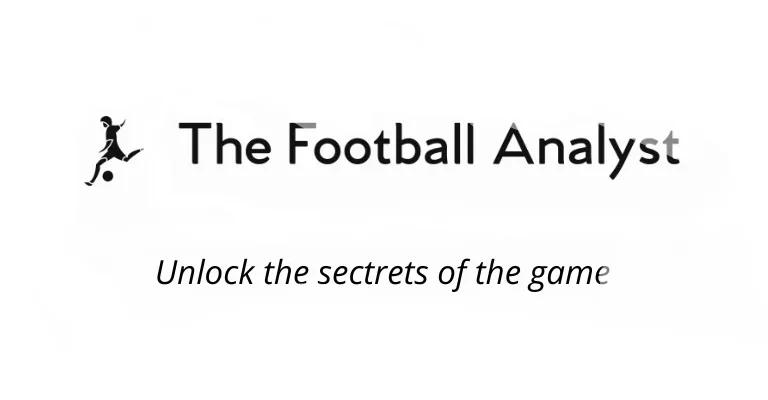Ruud van Nistelrooy has brought his sharp footballing mind to Leicester City, transforming their style of play with a clear tactical approach. Under his guidance, the team has evolved, showcasing a mix of attacking flair and defensive organization. In this tactical analysis, we break down van Nistelrooy’s strategies, formations, and the key principles that define Leicester City’s performances. Let’s dive into how the Dutch legend is leaving his mark on the Foxes.
Build-up
Low Build-up
In the low build-up, van Nistelrooy usually sets his team up in a 1-4-2-3-1 formation, with a back four, two holding midfielders, one number-ten, two fluid wingers, and a striker up top.
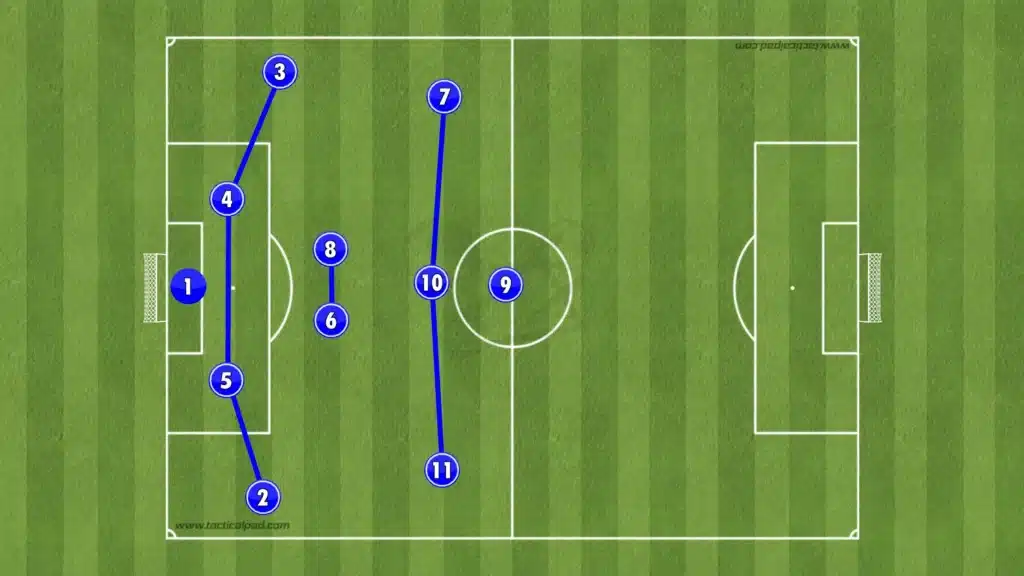
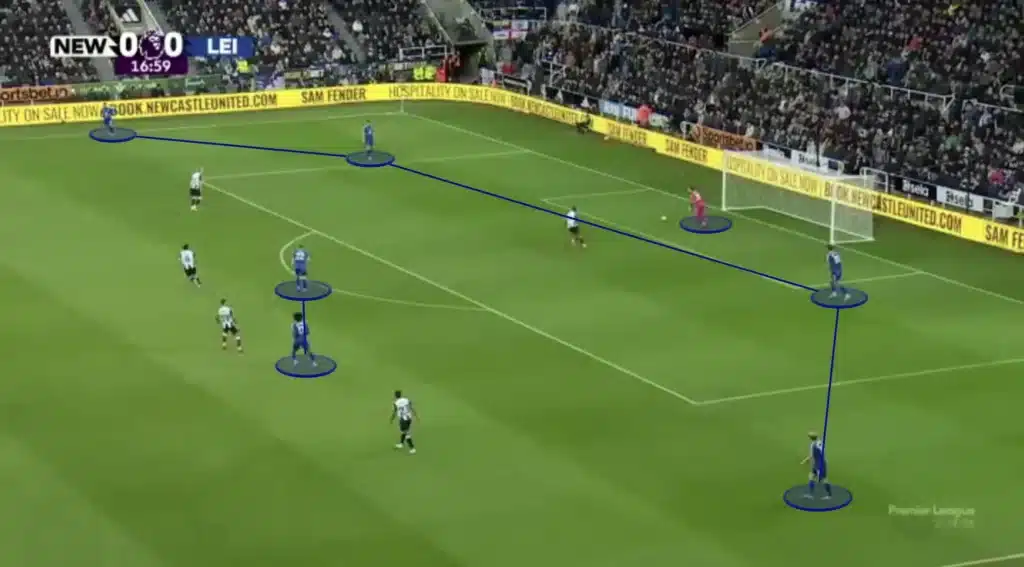
Leicester’s goalkeeper, Hermansen, often steps up into the backline during the low build-up, showcasing his excellent ball-playing ability. With precision, he delivers both short and long passes, adding an extra layer of composure and creativity to Leicester’s build-up play.
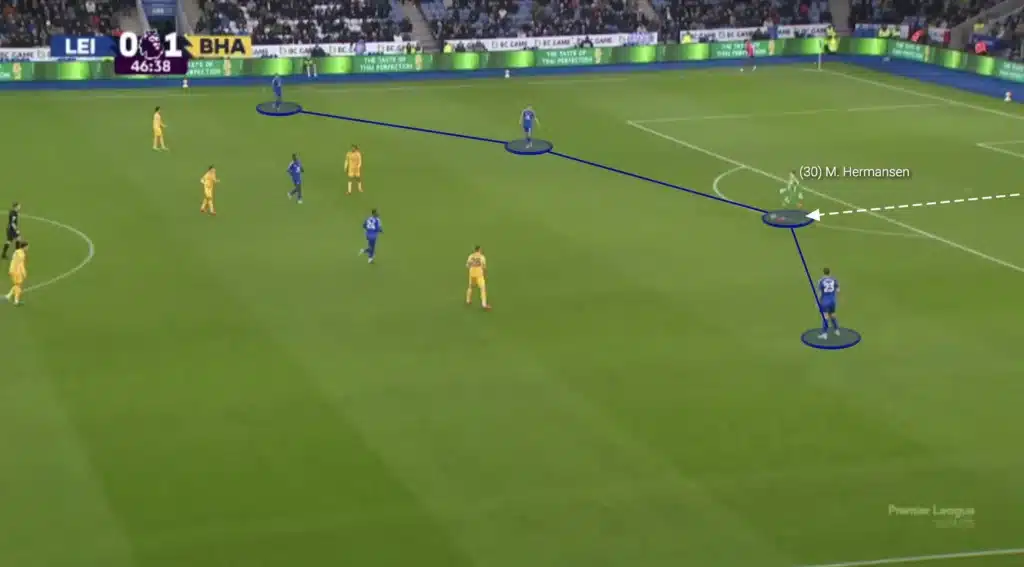
Van Nistelrooy mainly wants his team to beat the opposition’s press by finding an attacking midfielder in the space between the opposition’s defense and midfield, who can bounce the ball to a holding midfielder, who then can progress the ball forward. When Leicester beat the press, the attackers will immediately make runs in behind, looking to exploit the space behind the opposition’s backline.
The Leicester players are also not afraid to be more direct in the low build-up. If the opposition comes up and presses man-to-man, there will be numerical equality up top with the Leicester attackers against the opposition defenders. The goalkeeper, Hermansen, will often find an early longer ball up to the attackers, aiming to win 4v4 or 3v3 situations. The Leicester attackers have good individual quality and will often win these battles to create goalscoring opportunities.
High Build-up
In the high build-up, van Nistelrooy wants his team to rotate into a 1-3-2-2-3 formation.
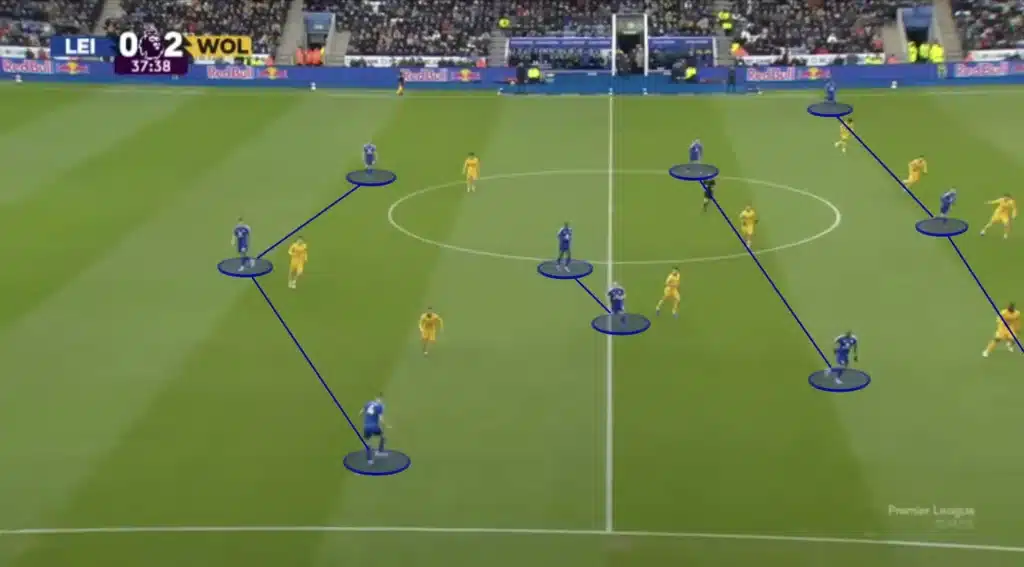
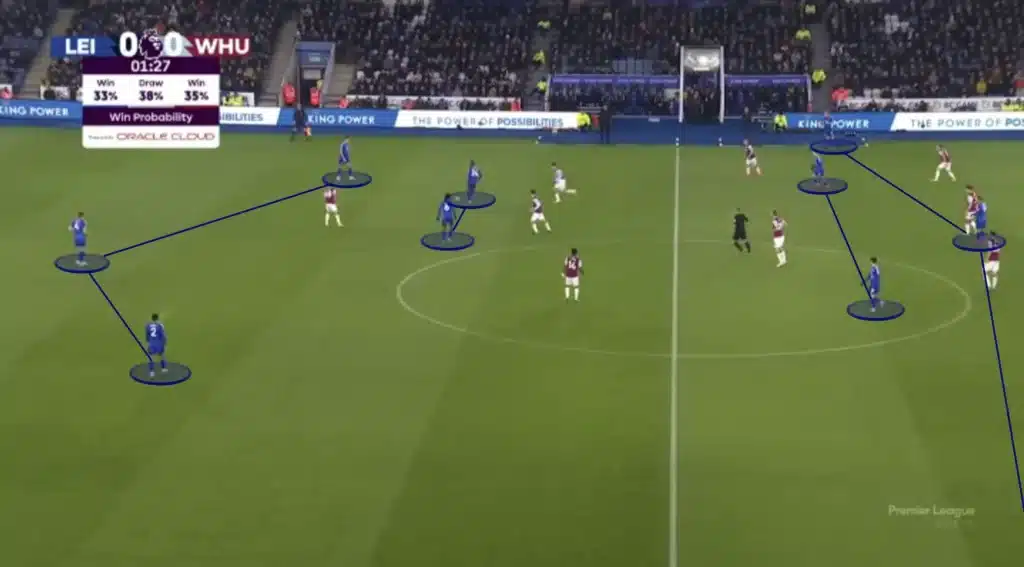
Building up in a 1-3-2-2-3 formation focuses on creating numerical superiority and controlled progression. The back three provide stability and width, while the two holding midfielders sit in front to offer passing options and protect against counterattacks. The two attacking midfielders position themselves between the opposition’s midfield and defensive lines, creating central overloads and linking play. The front three stretch the field horizontally, with wingers staying wide and the striker occupying central defenders.
Staggered Midfield
Van Nistelrooy usually wants the two holding midfielders to be in different lines during the build-up. This is crucial for creating passing lanes and disrupting the opposition’s defensive structure.
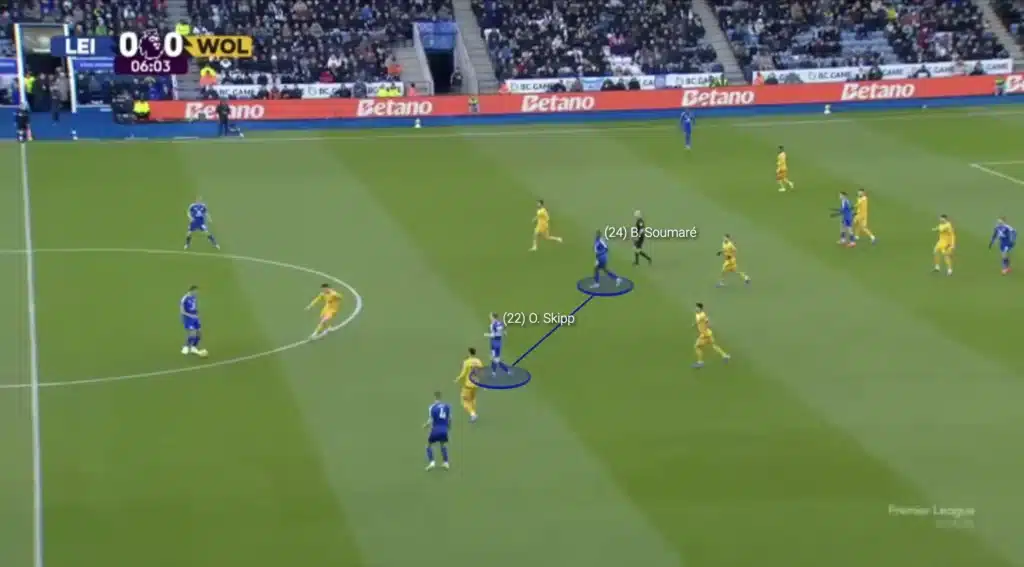
When the holding midfielders are staggered—one slightly ahead of the other—it forces the opposition’s attackers to make difficult decisions on who to block off, opening up space for the team to advance the ball. This layered positioning also enhances ball circulation by providing multiple angles for passing, reducing the risk of predictable or intercepted passes. The holding midfielders can play between themselves, allowing them to find third-man combinations to beat the opposition’s first line of pressure.
Numerical Advantages in the Middle
In the 1-3-2-2-3 formation, there will be a winger wide on each side, and the remaining eight players will be in the center. This means Leicester will almost always be numerically superior to the opponent in the midfield. Van Nistelrooy likes this because he prioritizes playing through the middle. He needs one player out wide to pull the opposition apart while the rest create numerical advantages in the midfield areas.
When a team outnumbers the opposition in the midfield, it can more easily retain the ball, exploit spaces, and progress the ball through the center. Leicester will often progress the ball through quick central passes between the midfielders, beating the opposition’s press and exploiting gaps in the defense.
Another purpose for keeping many players in the middle is to shorten the distance between them. This shortens the length of the passes, which naturally shortens the time between passes. This means the opposition players will have less time to push up and press, giving the Leicester players more time and control.
Rest-Defence
Van Nistelrooy also wants many players close to the center to create a good rest-defence structure. Rest-defence in football refers to a team’s defensive organization and structure when they have possession of the ball, specifically aimed at being prepared to defend immediately if they lose it. A good rest-defence structure is crucial for maintaining balance and preventing counterattacks when the team is in possession.
Having many players in the middle and close to the ball gives Leicester a good rest-defence, since it allows more players to counterpress when they lose the ball. When losing possession, the four or five Leicester players closest will immediately jump on the opposition player with the ball and close the distance to cut off any passing lanes. This approach disrupts the opponent’s transition from defense to attack, forcing errors and creating opportunities to regain control of the ball.
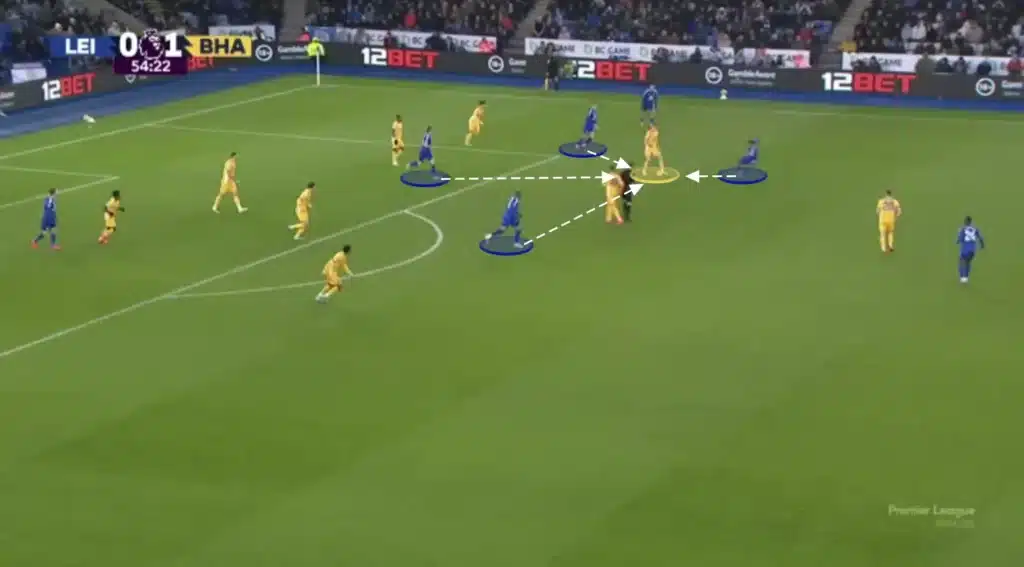
Counterpressing like this keeps Leicester on the front foot, allowing them to dominate possession and create more scoring opportunities. However, it requires exceptional fitness, tactical discipline, and teamwork.
Formation Changes
Leicester’s fluidity in the build-up under Van Nistelrooy has been a key aspect of their tactical evolution. The team usually adopts a positional approach, looking to keep the players in their fixed positions and progress the ball through different patterns. However, in some games, they have shifted between formations to create numerical advantages and exploit spaces. One of the holding midfielders has, for example, often moved up into a number-ten position, creating a 1-3-1-5-1 formation. This rotation gives Leicester more players higher up the pitch and can help break down teams who defend deep in a low-block.
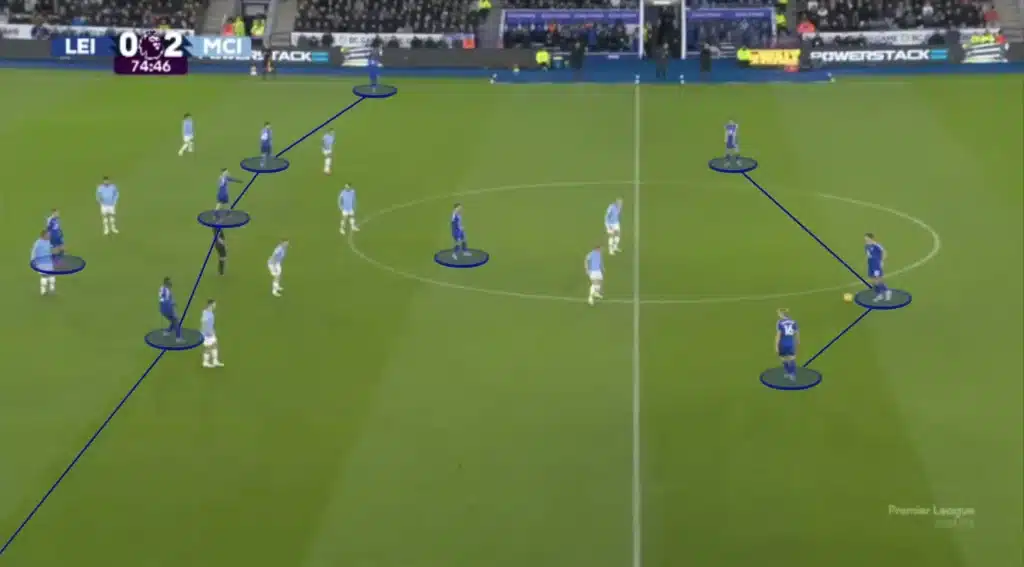
One of Leicester’s holding midfielders can also drop down into the backline to create a back four. This shift gives Leicester more control in their build-up and makes it easier for them to progress the ball past the opposition’s first line of pressure.
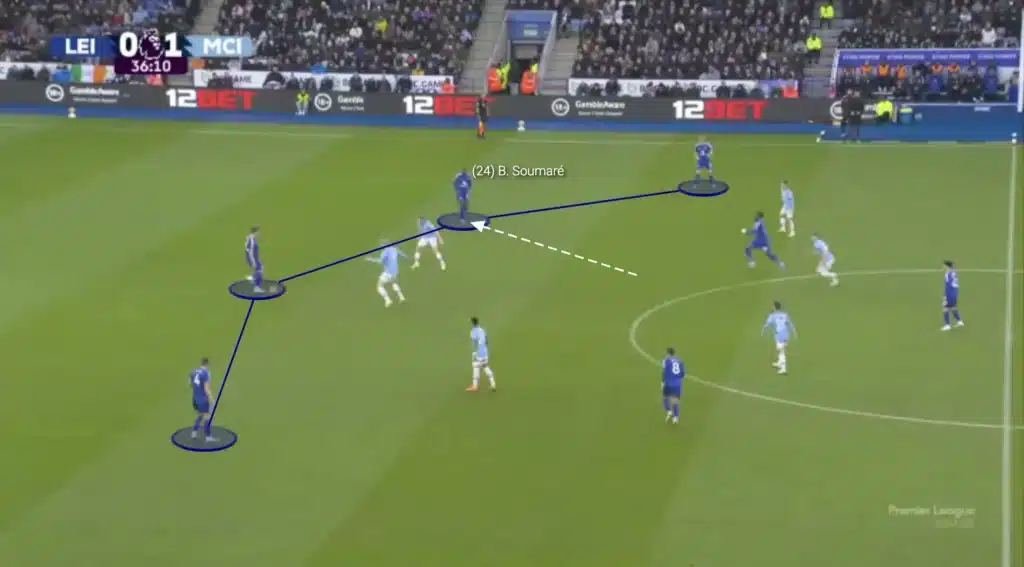
High Backline (Off)
A massive aspect of Leicester’s high build-up is to have the defenders high up and close to the center. This helps in the counterpress because they get closer to the midfield. Having more players close to the center who can win the ball back makes it difficult for the opposition to do anything when they win possession. Furthermore, the high backline shortens the distance between players, shortening the time and length of the passes and preventing the opposition from pushing up their defense.
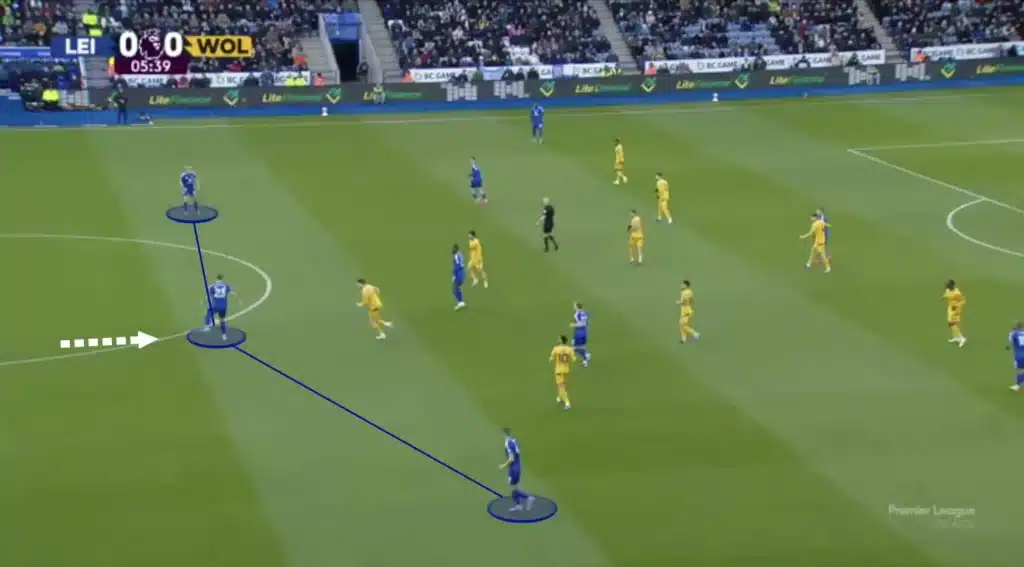
Third-Man
Van Nistelrooy wants his team to play through the opposition when possible. One vital tool they often use to do this is the third-man principle. The third-man principle is a tactical concept used to create and exploit space by involving a third player in a passing sequence.
It typically works by having Player A pass the ball to Player B, who then quickly relays it to the free Player C. An opponent will block the pass from Player A to Player C, but the pass from Player B to Player C will be open, which is why he is needed in this passing combination.
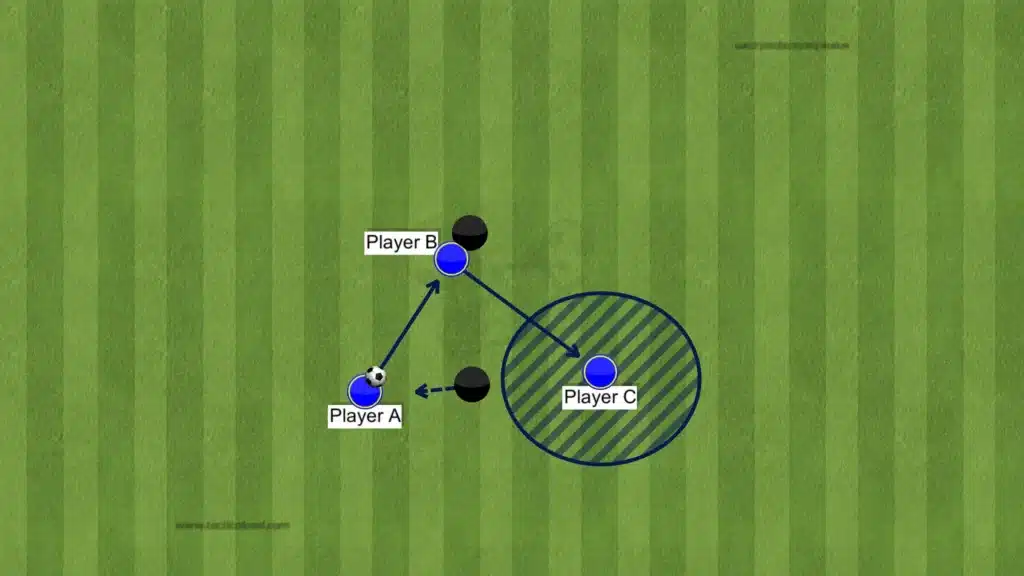
This movement often bypasses an opponent’s pressing line and opens up space, allowing the team to advance the ball more effectively. The key to the third-man principle is timing and positioning, as the third player must anticipate the play, position themselves advantageously, and receive the ball in a manner that breaks the opposition’s defensive structure. This principle is integral to many modern football strategies, promoting fluidity, quick decision-making, and dynamic attacking play.
Leicester will, for example, use third-man combinations involving the attacking midfielders to find an open holding midfielder in between the lines.
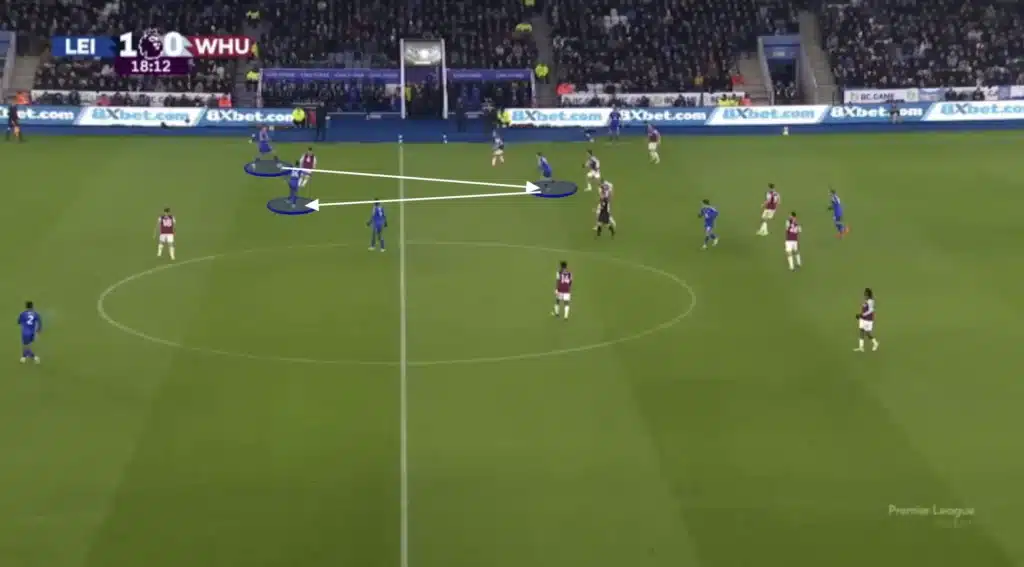
When they find their midfielders in these spaces, the attackers will immediately make runs in behind the opposition backline, looking to quickly get into goalscoring positions. They will especially look for diagonal balls to the opposite winger, who will make a run in behind on the blindside of the opposition fullback.
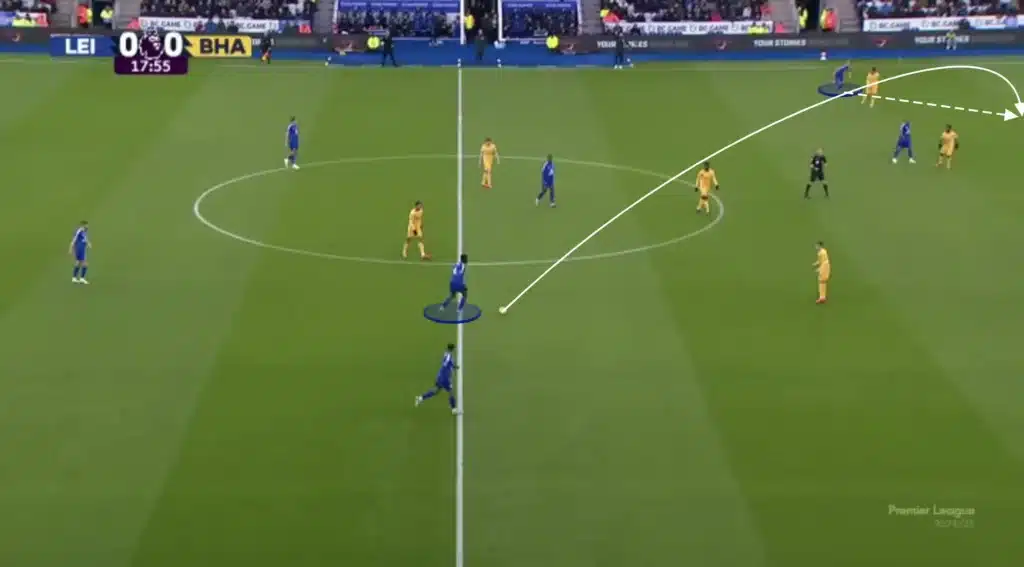
Progressing Through the Half-Spaces
Leicester City frequently utilize the half-spaces to progress the ball during the high build-up phase. The attacking midfielders play a crucial role by dropping into these areas, positioning themselves just outside the opponent’s defensive block. This movement creates passing lanes from the backline, allowing the defenders to bypass the opposition’s midfield with incisive passes. Once the attacking midfielders receive the ball in the half-spaces, they can turn and drive forward, linking up with wide players or the striker to create attacking opportunities.
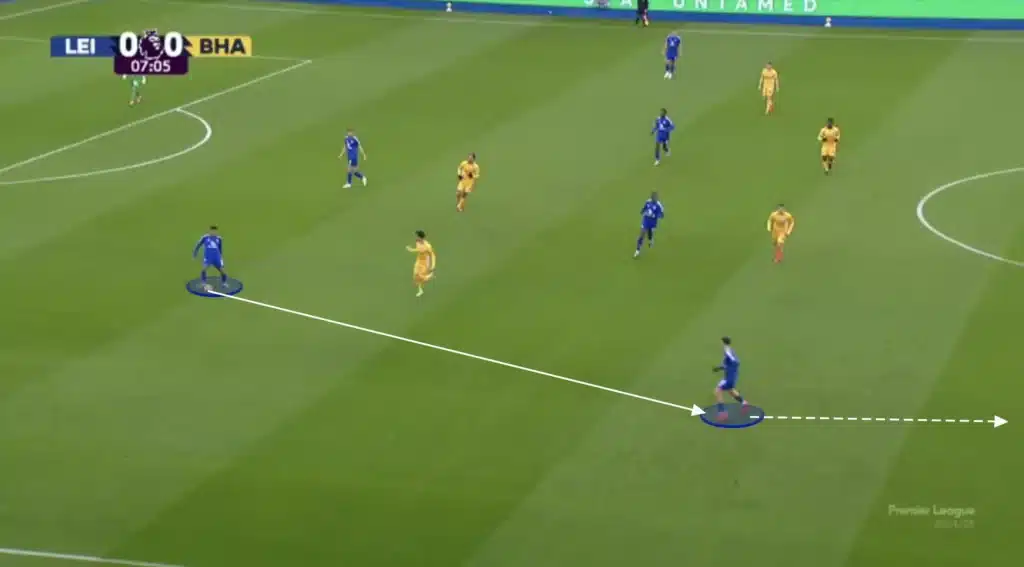
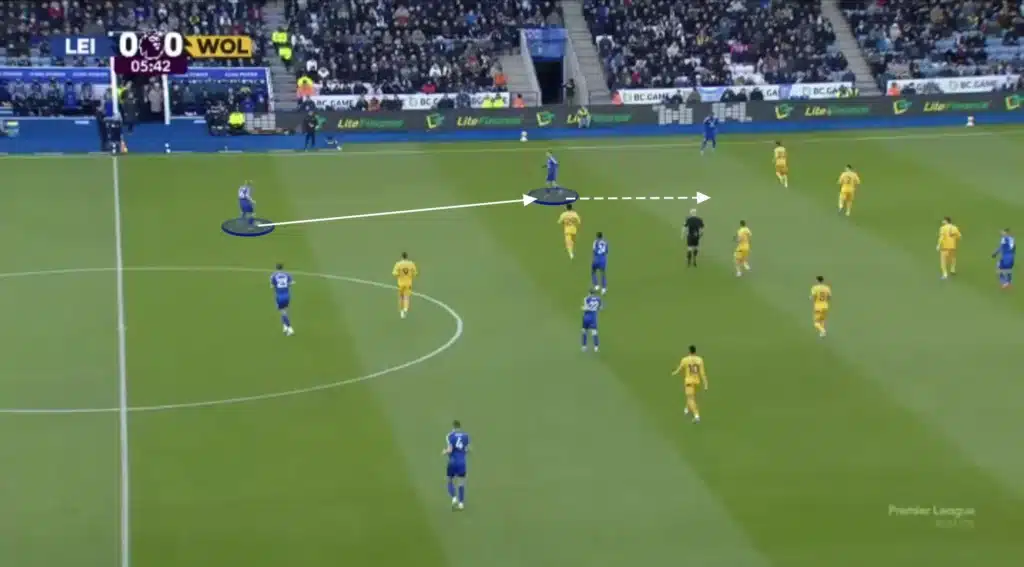
This strategy not only ensures vertical progression but also disrupts the opposition’s defensive structure, making it harder for them to maintain compactness.
Counter-Movements
In the 1-3-2-2-3 formation, 2v1 situations can often be created against the opposition fullback. If the attacking midfielder moves a little bit higher to be closer to the winger, the defending fullback will have two players to keep an eye on, which can cause issues.
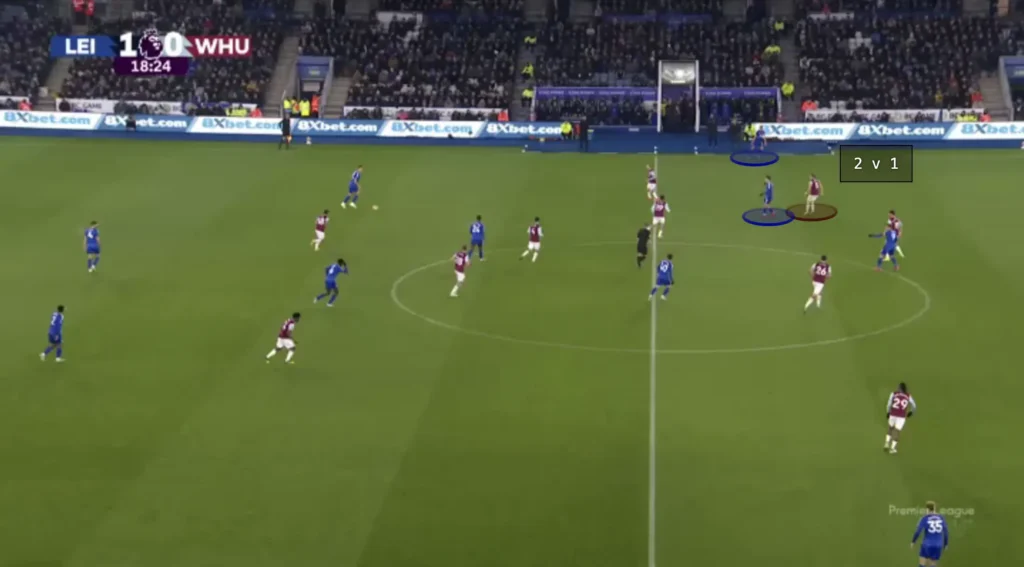
Leicester will mainly use counter-movements between the winger and attacking midfielder to exploit this numerical advantage. When a wide center-back has the ball, the attacking midfielder can make a run in behind while the winger drops to open the passing lane from the wide center-back.
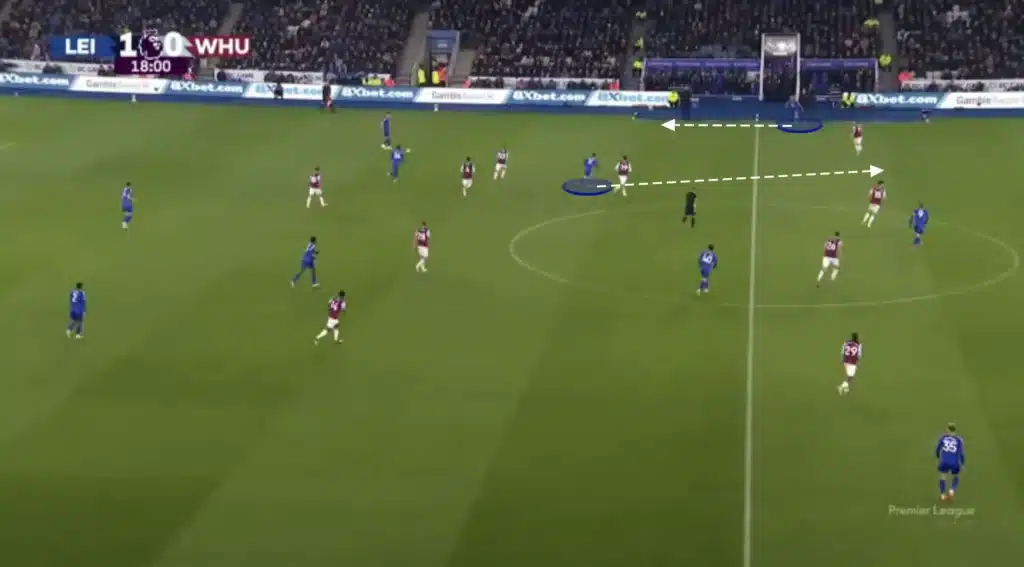
This creates a question for the opposition fullback. If he steps out on the winger, the space behind him opens up, allowing the center-back to play a through-ball to the attacking midfielder. However, if he stays inside to cover the run, the ball can be played to the winger, who can turn and attack the defense.
In this situation, the fullback stays back to have control of the attacking midfielder, which allows the winger to receive a pass and drive the ball forward.
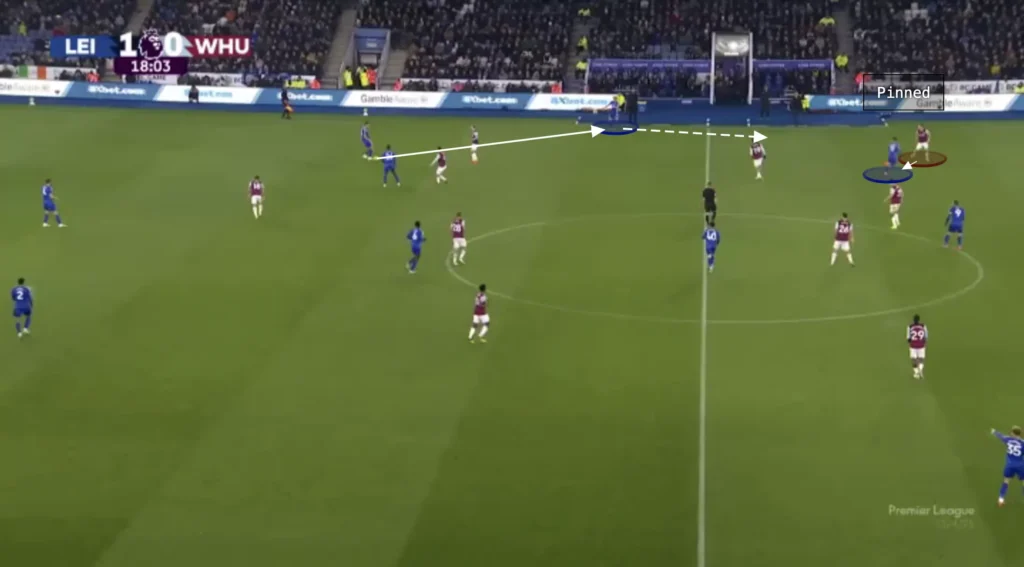
Defending
Leicester’s base formation when defending is the 1-4-4-2 formation. They look to set up in a mid-block, always trying to close the center and force the opposition out wide.
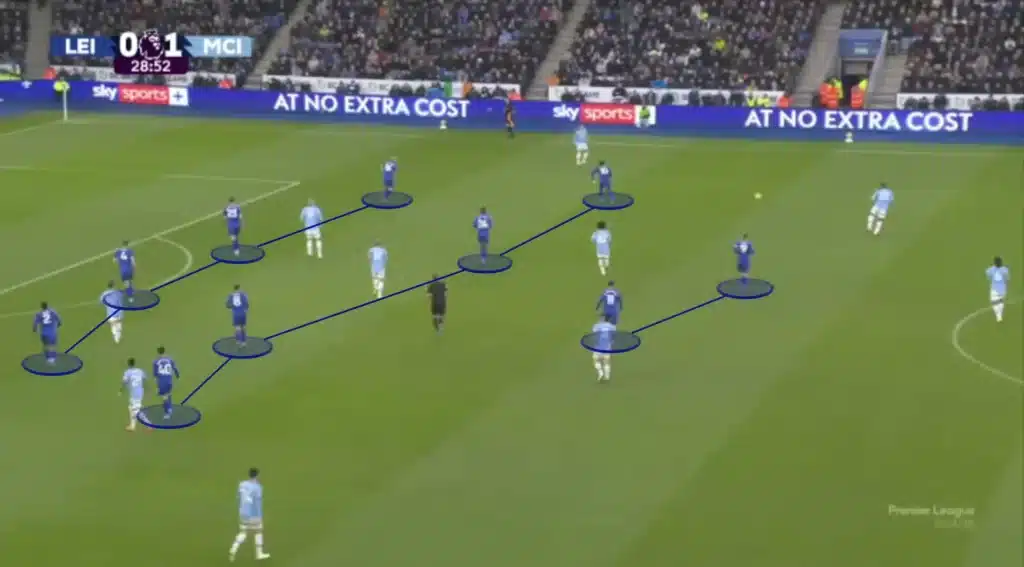
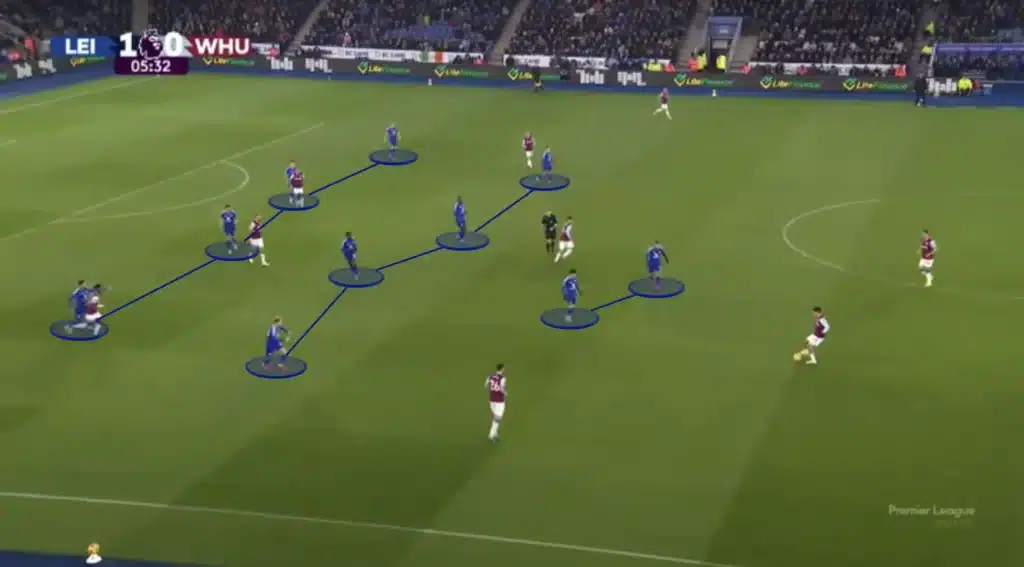
Defending in the 1-4-4-2 formation is all about balance, compactness, and discipline. The team defends in two compact lines of four, with the forwards positioned ahead of the midfield. The two forwards play a crucial role, not only as the first line of defense but also in initiating the team’s pressing strategy. Van Nistelrooy wants his team to stay compact without dropping too low, preferably closing the space between the midfield and backline.
High Backline (Def)
Van Nistelrooy values compactness when defending and, therefore, wants Leicester to defend with a high backline, making the space from the backline to the midfield line as small as possible. Defending with a high backline involves positioning the defensive line closer to the midfield rather than near the goalkeeper. This tactic compresses the space available for the opposing team to operate, disrupting their build-up play and increasing the chances of winning the ball back quickly.
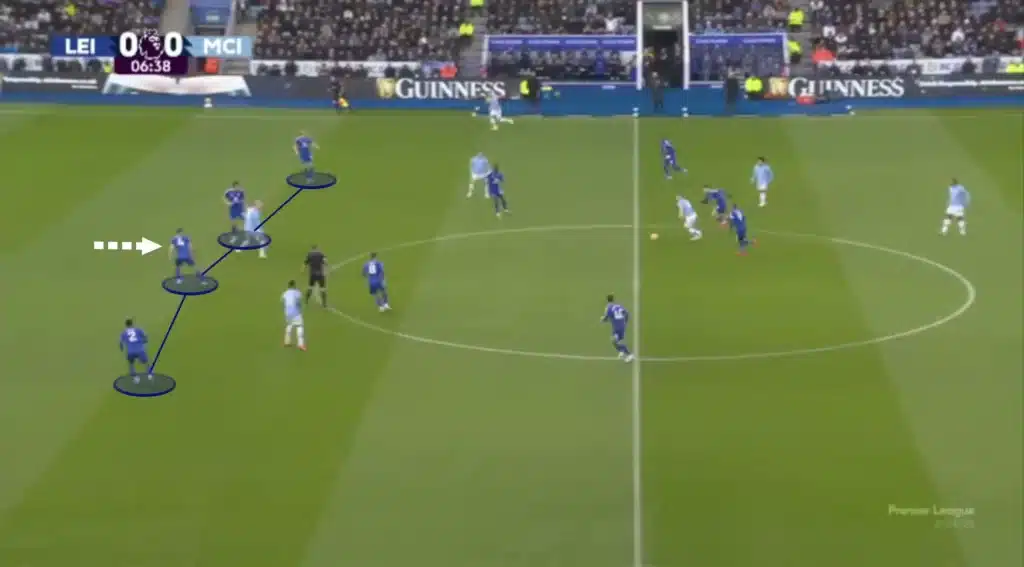
A high backline also allows defenders to support the midfield more effectively, creating numerical superiority in central areas and facilitating quicker transitions from defense to attack. However, it requires defenders with good pace and positional awareness to deal with long balls and prevent opposing attackers from exploiting the space behind.
Additionally, everyone must be in the same line when defending with a high backline to maintain an effective offside trap, ensure cohesive coverage, and reduce gaps that attackers can exploit. A well-aligned defensive line makes it easier to catch opposing forwards offside, preventing them from receiving the ball in dangerous positions.
Body Position
When defending with a high backline, the defenders must always be ready to run back if the ball gets played in behind. Van Nistelrooy, therefore, puts a lot of focus on the defender’s body position. He wants them to play side-on, being ready to run both forward and backward. Tracking a run in behind is more difficult when facing forward than if you play side-on. If you are facing forward, you have to turn your entire body before starting to run. Playing side-on gives a quicker reaction time, enabling faster movement in both directions.
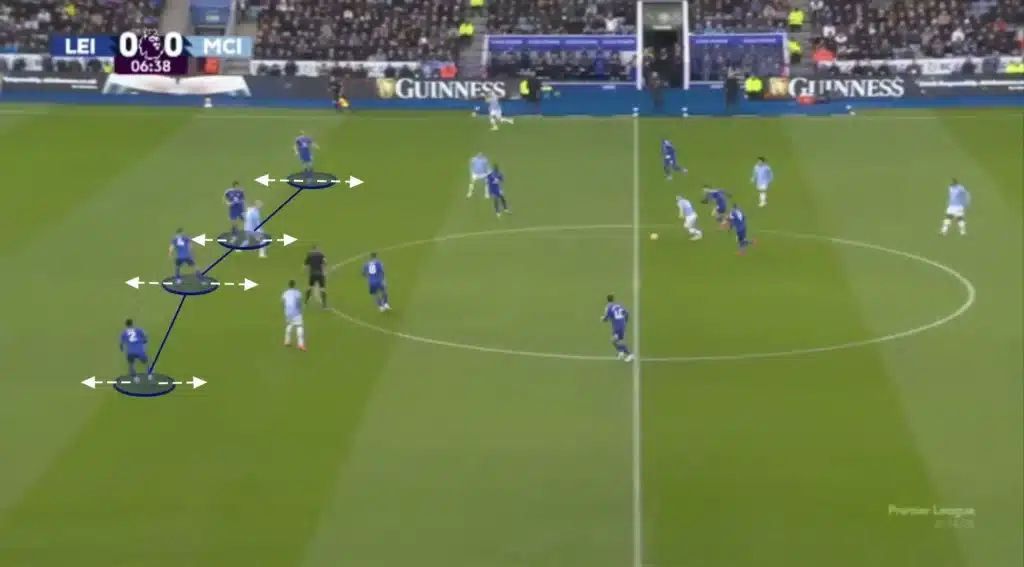
Work Rate
Leicester’s work rate when defending is exceptional, defined by relentless energy and discipline. Under Van Nistelrooy, the team is organized and compact, with every player contributing to defensive duties. The midfield and forward lines press with intensity, closing down spaces and forcing opponents into uncomfortable positions. Leicester’s backline remains focused, consistently tracking runs and maintaining their shape. When a defender breaks out of shape to put pressure on an opposition player, a Leicester midfielder will always drop into the backline to cover for his teammate.
They will mainly do this to close the space between the center-back and the fullback. By having a central midfielder step into these gaps, Leicester create a back five, allowing them to maintain their defensive shape, prevent overloads, and provide additional cover for their fullbacks, especially when they are pushed out wide.
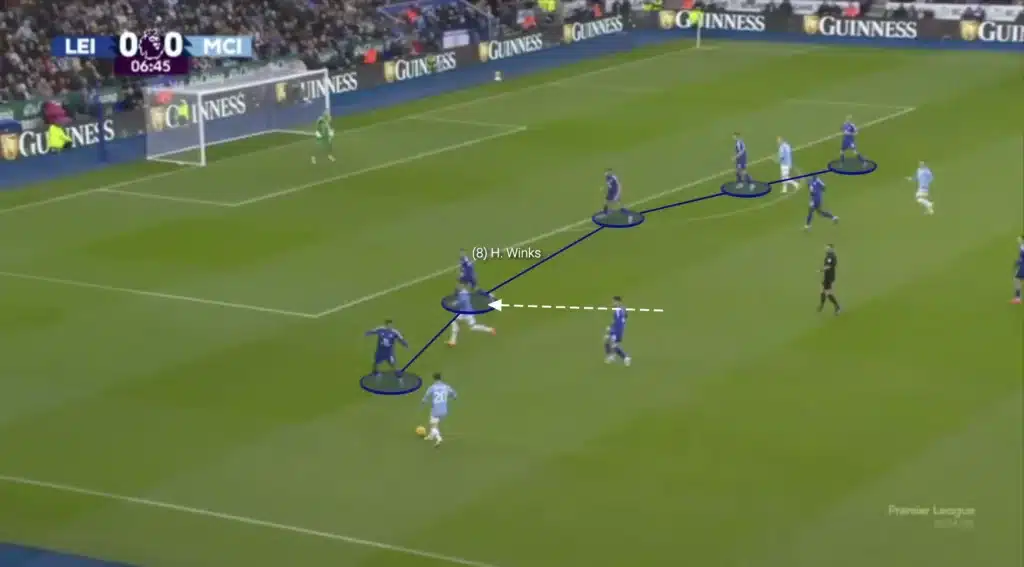
This compactness ensures that the team stays solid defensively, making it harder for the opposition to break through with wide or central attacks. Additionally, midfielders covering these spaces allow the center-backs to stay in the box in crossing situations.
Final Thoughts
Ruud van Nistelrooy has brought a fresh tactical approach to Leicester City, blending structure with creativity. His emphasis on fluid attacking play, defensive organization, and adaptability has given the team a clear identity. While challenges remain, such as consistency and fine-tuning transitions, the progress under his guidance is evident. Leicester City is evolving into a dynamic and disciplined side, and if Van Nistelrooy continues on this trajectory, the club’s ambitions for success seem well within reach. The Foxes are not just rebuilding—they’re laying the foundation for an exciting future.
